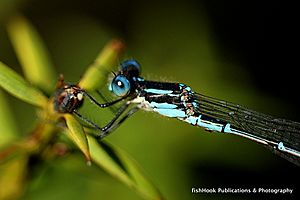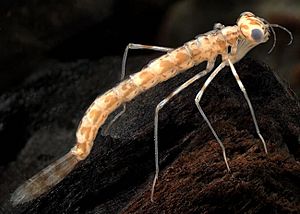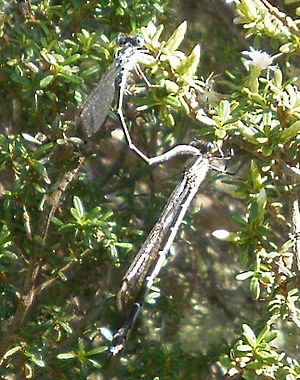Austrolestes colensonis facts for kids
Quick facts for kids Austrolestes colensonis |
|
|---|---|
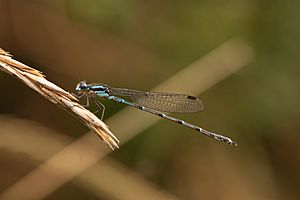 |
|
| Male | |
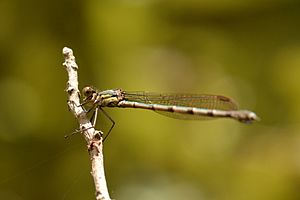 |
|
| Female | |
| Scientific classification | |
| Synonyms | |
|
The Austrolestes colensonis, also known as the blue damselfly, is a type of damselfly. In the Māori language, it is called kekewai. This damselfly lives only in New Zealand. You can find it all over the country, at any time of the year. It is New Zealand's biggest damselfly. It is also the only blue odonate (a group that includes damselflies and dragonflies) found there.
Contents
How the Blue Damselfly Got Its Name
The blue damselfly was first described in 1846 by Adam White. The first mention of this insect was a drawing. It was called Agrion colensonis. Later, in 1862, Edmond de Sélys Longchamps wrote about it. He used the name Lestes colensonis.
A New Zealand insect expert, George Hudson, also described and drew this damselfly in 1904. He used the name L. colensonis. In 1913, Robin Tillyard placed this species in the group Austrolestes.
What Does the Blue Damselfly Look Like?
The blue damselfly is the largest damselfly in New Zealand. Its wings can spread about 5.4 centimeters (2.1 inches). Its body is about 4.4 centimeters (1.7 inches) long.
Male Blue Damselflies
Male damselflies are mostly dark purplish-black. They have bright blue markings. Their eyes are wide apart and blue. They have three shiny blue stripes on their body, separated by black. Each part of their tail (abdomen) has a blue ring. The rest of the tail is black. Their legs are black on top and yellowish-brown underneath.
Female Blue Damselflies
Female damselflies are similar to males. However, their tail is thicker. They have long, thin parts at the end of their tail. Young males and all females are shiny green, not blue.
Blue Damselfly Larvae
The young damselflies, called larvae, are about 1.7 to 2.1 centimeters long. They have a wide head with big eyes. Their body is round. The tip of their tail gill is rounded and has no hairs. They also have three horizontal brown stripes.
Where Do Blue Damselflies Live?
You can find this damselfly all over New Zealand. This includes Stewart Island and Chatham Island. The damselflies on Chatham Island seem a bit different. However, they are still considered the same species.
You can see A. colensonis near water at any time of the year. They are most common from November to April. Some adults seen in June and July might be staying active through winter. They are often found in mountain lakes. This means they can handle cold temperatures well.
Life Cycle of the Blue Damselfly
The blue damselfly has a two-year life cycle. Some eggs hatch in the summer they are laid. Other eggs stay dormant through winter and hatch the next spring. Temperature is very important for how fast they grow. If it's too cold, the tiny damselfly inside the egg might die.
Eggs can hatch in about 20-21 days if the temperature is around 20 degrees Celsius. The young damselflies, called nymphs, then live for one to one and a half years. After this, they change into adult damselflies. Before they emerge, the nymph turns almost black. They might take short trips out of the water a few days before they become adults.
Becoming an Adult
Damselflies usually emerge (come out of the water as adults) on grass or rush stalks. These stalks are usually 10-40 centimeters above the water. Many young adults die during this process. They might lose their grip and fall into the water, where they can drown.
Emergence happens during the day, from October to February. Most emerge around January. However, adults can be found as late as May in some areas. After they emerge and take their first flight, young adults become ready to mate. This takes several days. During this time, they might fly to new places.
Mating and Laying Eggs
Once males are ready, they look for good places to breed. They set up their own territories. They stay still in their spot until another damselfly bothers them. In the early afternoon, when they are most active, males chase females that fly into their area.
Mating looks like a "wheel" shape and lasts about 10 minutes. The female usually lays eggs with the male still attached. They land on a floating plant. The female pushes a sharp part into the plant stem. She then lays 6-9 eggs, which takes about a minute. She repeats this, laying eggs close together or spaced out.
When the tiny nymphs hatch, they look for water. They then shed their skin and become a second, slightly larger larva. These nymphs are good swimmers. When they get bigger, they move around on the bottom of ponds, among plants and bits of dead material.
Blue Damselfly Behavior

The young damselfly larvae are very active. They can jump and swim very fast when disturbed. They hold their legs close to their body and swim to the bottom. There, they bury themselves in the mud.
What They Eat
Blue damselfly larvae eat many different small water creatures. These include small worms, tiny animals called rotifers, and different types of small crustaceans. They also eat water mites and other insect larvae, like those of midges. Blue damselfly larvae can even eat other damselfly larvae! They hide among underwater plants. Then, they ambush their prey.
How They Act
A. colensonis larvae can be aggressive. They often stay still in one spot for hours. They get easily bothered if something disturbs them. Scientists have seen them make different body shapes and movements when they are in aquariums. They defend their space from other damselflies. If too many larvae are together, they might even lose legs or tail parts from fighting.
Changing Color
Adult A. colensonis can also change their body temperature. They do this by changing how blue they look. Males are pale blue-purple in the morning or after being cold. But as they warm up, their body becomes a brighter blue. Females that are warm enough can also look bluish.
Who Are Their Enemies?
Even though blue damselfly larvae are often strong in their watery homes, they still have enemies. Fish and beetles are some of their predators. The larvae hide from these predators in weeds and underwater plants.
Humans also affect how many blue damselflies survive. When people change streams, ponds can dry up. This means larvae cannot live, and eggs cannot hatch. Natural events like droughts can also dry up ponds and streams. This has the same deadly result for the young damselflies.



